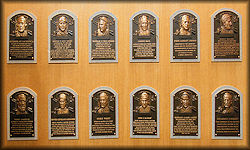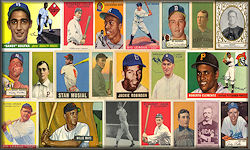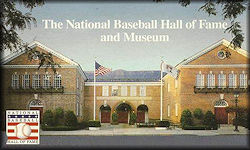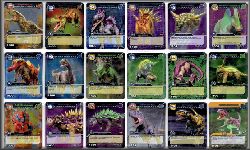"Casey (Stengel) knew his baseball. He only made it look like he was fooling around. He knew every move that was ever invented and some that we haven't even caught on to yet." – Sparky Anderson
Casey Stengel's 54 distinguished years in baseball spanned everything from the Dead Ball Era to Mickey Mantle’s booming home runs. Through it all, Stengel’s colorful personality and instantly quotable remarks made him one of baseball’s most beloved characters.
Stengel’s first full major league season as a player began in 1913 as the first Brooklyn player to bat, and subsequently homer, at Ebbets Field. After nine big league seasons in Brooklyn, Pittsburgh and Philadelphia, Stengel was traded to the New York Giants midway through the 1921 season. The young player was already gaining attention for his zany antics on the diamond.
"(Stengel) is a dandy ballplayer, but it's all from the neck down," remarked scout Mike Kahoe.
The Kansas City native found a home at the Polo Grounds when he became Hall of Fame manager John McGraw’s protégé and unofficial assistant coach. From 1922-23, Stengel hit .355 as a platoon outfielder with the Giants and homered in Game 1 of the 1923 World Series.
Stengel hit another home run in Game 3 and thumbed his nose at the New York Yankees bench while rounding third base. Baseball commissioner Kennesaw Mountain Landis was in attendance that day and promptly fined Stengel for his antics.
“Casey Stengel just can't help being Casey Stengel,” Landis lamented.
After two more seasons in the major leagues, Stengel spent several seasons managing in the minor leagues. This included a memorable moment when Stengel released himself as a player, fired himself as a manager and resigned as owner of Boston’s minor-league Worcester affiliate club to manage Triple-A Toledo.
Stengel eventually earned a big league shot as manager of the Dodgers (1934-36) and the Boston Braves (1938-43) with middling success. "I became a major league manager in several cities and was discharged,” Stengel later recalled. “We call it discharged because there is no question I had to leave."
Finally in 1949, Stengel got a call from Yankees Hall of Fame owner George Weiss to lead a team loaded with talent.
“There is less wrong with this team than any team I have ever managed,” Stengel said. Featuring stars like Yogi Berra, Joe DiMaggio, Phil Rizzuto and a young Mickey Mantle, Stengel’s Yankees found immediate success and became the first team to win five consecutive World Series championships from 1949-1953. Stengel is often credited with reviving the practice of “platooning” his players when he took over the pinstripes, a tactic he learned from McGraw during his days with the Giants.
When asked to divulge his managerial strategy, Stangel deadpanned, "Keep the five guys who hate you away from the five who are undecided.”
While his team hogged the baseball spotlight, Stengel took the opportunity to expand his repertoire of odd sayings that would later be affectionately dubbed ‘Stengelese.’ His famous sayings included everything from the obvious ("You got to get twenty-seven outs to win”) to the head-scratchers ("There comes a time in every man's life, and I've had plenty of them”).
The Yankees fired Stengel following a loss in the 1960 World Series, citing Stengel’s advancing age. Two years later, Stengel returned to the Big Apple to manage the expansion Mets and captured the hearts of New Yorkers all over again.
Celebrated as baseball’s lovable losers, the Mets lost 404 games in Stengel’s three and a half years at the helm, prompting the old skipper to ask, "Can't anybody here play this game?"
Stengel finally retired in 1965 with seven World Series titles, tied with fellow Yankees manager Joe McCarthy for the most all-time. A year later, he was inducted into the Hall of Fame.
"It is fashionable to say that successful people, in any field, could have been whatever they wanted,” wrote Mickey Herskowitz in the Houston Post. “But you could not picture Casey Stengel being anything else but what he was, the greatest showman baseball ever knew." (Ref: National Baseball Hall of Fame) |





